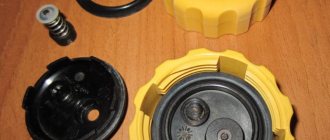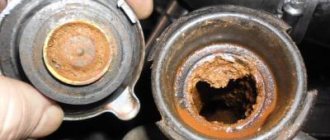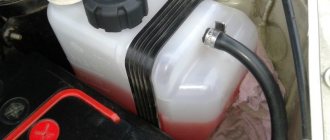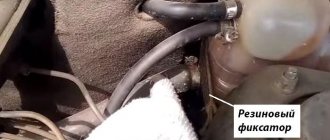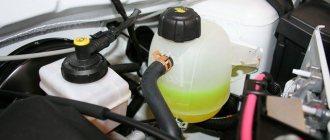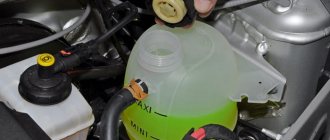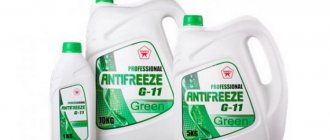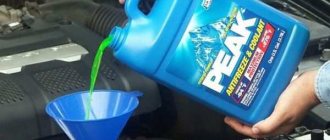What to do if the antifreeze is knocked out
First of all, it is necessary to localize the location of the leak.
Perhaps you will find the reason there. Most often (especially on cars with high mileage), flange connections simply collapse or hoses burst. High pressure coupled with temperatures under 100 °C will easily squeeze out an element worn out from age. After replacing a faulty unit, be sure to check the operation of the valve on the expansion tank cap. The valve on the cover cannot be restored, so the element must be replaced. If it can be disassembled, check the integrity of the spring and membrane. In some cases, removing dirt and crystals from mineral supplements is sufficient.
The gaskets are replaced with new ones; no restorative sealants will withstand pressure at high temperatures.
Tank check
Another reason is a defect in the tank itself. It can burst, both after several years of use and after a week of driving the car. Low quality plastic, constant high pressure - and you have a crack in the tank through which antifreeze leaks.
Have you made sure that the expansion tank is intact, but still don’t know why it is throwing out antifreeze? Another reason for the constant “loss” of antifreeze is overheating of the car. Constantly high engine temperature, improper operation of the radiator, malfunction of the pump - the antifreeze simply boils.
Main reasons
Expansion tank cap
There are several main reasons for the release of coolant through the expansion tank.
They are divided into several groups depending on what exactly the problems are associated with.
Similar phenomena occur on a variety of vehicles, including:
- VAZ 2114;
- Gazelle;
- KAMAZ;
- DAF;
- Lada Kalina;
- Nissan Almera;
- Mitsubishi Lancer;
- Hyundai Accent;
- Volkswagen Polo;
- Nissan Qashqai;
- Daewoo Lanos;
- Lada Granta;
- Mazda 6;
- Mercedes;
- Audi A5, etc.
The likelihood of encountering a similar problem is higher for cars with a higher mileage. Although we cannot rule out antifreeze emissions from cars that were only recently purchased and put into operation.
Let's look at the possible reasons separately.
Tank malfunctions
At first it may seem that the tank is designed extremely simply, and there simply cannot be any significant problems with it.
But it is because of the tank that the coolant most often begins to eject.
The seal is broken. Antifreeze has a high fluidity, which is why it can penetrate even through small cracks that are not visually noticeable. Thus, when the pressure increases, the liquid is squeezed out. Check for stains under the car after parking. It is best to completely replace the tank if there is leakage;
Defective threaded connections
When checking the expansion tank cap, pay attention to the threads of the neck and the valve itself. Cheap and low-quality products often have burrs and chips, which make a tight fit impossible.
An increase in pressure provokes coolant leakage through these channels;
Valve. The valve cover is also a common cause of fluid leaking from the reservoir. Moreover, the problem is quite easy to identify. Everything works fine at idle. But by increasing the speed, under load, the liquid is literally pushed out from under the valve. First try to disassemble and clean the element. If this does not help, the valve needs to be replaced.
But these are not the only possible reasons. Let's move on in search of the truth.
Coolant circulation is impaired
If circulation is disrupted, the fluid overheats greatly, pressure increases and coolant is squeezed out through the valve cover.
There are several reasons here.
The potential reasons don't end there
There is one more important point that is worth paying attention to
Leak formation
Most often, motorists are faced with a shortage of coolant in the cooling system. When the volume of antifreeze drops, the temperature rises as the engine cools. Heating leads to active evaporation and an increase in pressure.
If, when the engine cools down, the level remains unchanged in the tank, then you need to look for a problem in the circulation. And when the level drops, then the seal is broken. That means there is a leak somewhere.
There are several main probable causes of leakage:
- The pipes and hoses of the system are worn out and aged. They will need to be replaced, strengthening the new parts with additional clamps to increase the reliability of the connections;
- Cracks in the heater cores and cooling system. If the problem is in the stove, then antifreeze will leak into the cabin. Usually at the front passenger's feet;
- Problems with the pump and thermostat seals. Look for traces of antifreeze near those elements that act as suspects;
- The cylinder head gasket is broken. In this case, the cylinder head gasket will need to be replaced. The danger is that the coolant can penetrate the engine cylinders or lubrication system, mixing with the oil. The consequences can be extremely disastrous for the engine, including jamming of the internal combustion engine.
Now you are clearly convinced that there is nothing good in throwing out antifreeze through the expansion tank. When the first signs appear, be sure to stop the car, start looking for the causes and eliminating them.
If you have any difficulties with diagnostics or repairs, you can always contact a car service center.
Thanks everyone! Subscribe, invite your friends to join us and expect a lot of new and useful materials!
Real cases of malfunctions.
Oleg, VAZ 2114:
I noticed that when the engine is running, even to warm up, antifreeze presses through the plug. The fluid level also dropped, so I had to top it up periodically. I started looking for the problem. It turned out that the pump was at fault. Upon inspection, I saw that the timing belt protective cover was wet from the inside, and threads appeared on the block on the timing side. Thanks to the broken gasket of the water pump, the casing and block were splashed, and at high speeds after the engine warmed up, the coolant almost boiled and was thrown out through the valve. Since I took the car by hand, I didn’t bother to rebuild the pump - I installed a new one, now it doesn’t throw away and it’s dry.
Nikolay, Gazelle 4216:
There is a problem. Gazelle 4216, UMZ engine, new thermostat. When the engine warms up, everything is fine, it reaches operating temperature and the antifreeze begins to flow through the plug. The engine never overheated. I thought it was a crack in the head, but the oil level is normal, the antifreeze is clean, the fan works like a charm. Replacing the valve cover did not help. A thorough search for the cause at the service center showed that the gasket in the cylinder head had broken. The master said that the disease is known - it needs to be polished a little. It can be worse - often there are microcracks in the head, the beam should be changed immediately.
Peter, Chevrolet Niva:
I noticed that coolant drips constantly appear around the plug and under the reservoir on the body. I read descriptions of faults on the Internet and started looking everywhere I could. I didn’t find it - everything is normal, but the streaks remain. I took the car to the service center.
The master enlightened me - it turns out that this is a common occurrence on this machine. When the pressure is released, especially when the engine is warm, the antifreeze flows out in an intense stream with splashing. As a result, some of the coolant splashes out. The process is repeated constantly when driving, splashes appear through the hole in the plug and numerous drips appear.
He solved the problem in literally 2 minutes - he inserted a piece of brake pipe into the hole where the fluid comes from and directed it to the bottom. I’ve been happy for a week now – everything is dry.
Alexey, VAZ 2107:
For several days, a distinct smell of antifreeze appeared in the cabin. An inspection under the hood showed that the reservoir was wet. I started to see what was happening. You add gas - the level is in place, at idle it steadily creeps up. I turned it off again and the antifreeze began to leave the container. I felt the pipes - they seemed to be in order. The service department said that the thermostat died. I changed it, but the antifreeze still rose into the reservoir at idle. I was puzzled, because I had just recently changed the pipes, the cooling radiator and heaters, the pump, the cylinder head gasket - I installed everything new.
It was not possible to resolve the issue on our own; we had to turn to specialists again. They were smart for almost a week (and it was in this service that they changed everything for me). It turned out that when they changed the cylinder head gasket, they did not pay attention to the surface; when tightening it, it was pressed through. They removed the head, sanded it, replaced the gasket with a new one, carefully installed it and tightened it - the problem was gone.
Why does antifreeze squeeze out of the expansion tank?
G12 antifreeze, its features and differences from other classes of antifreeze
Often car owners are faced with the fact that antifreeze begins to squeeze out of the expansion tank. In this case, no visible reasons can be found (the pipes and the cover are intact, and after a long period of parking, no puddles appear under the car). In this case, you can diagnose what antifreeze is emitting through the expansion tank by measuring the refrigerant level or checking the following elements in a given order:
- expansion tank;
- engine radiator;
- stove radiator;
- thermostat housing;
- all possible joints and pipes;
- cooling system pump.
If antifreeze leaks, the causes and consequences may be more serious than it seemed, so it would not be superfluous to check the engine oil. A probe is used for this. If traces of light foam remain on it, this indicates that the refrigerant is mixed with oil.
If antifreeze goes into the engine, then you will find white spots on the spark plugs.
Upon closer examination, you will be able to identify one of the causes of leaks that form in different components.
Cooling system radiator
Carefully inspect the engine (it is better to wash the entire engine compartment first). One of the most common reasons is a leak in the cooling system components. In this case, the location of the problem is the radiator, which may have been pierced by a stone or other object thrown from under the wheels of oncoming traffic. If antifreeze is leaking from the radiator, then the plates are probably worn out, which were exposed to ethylene glycol, which is part of the antifreeze, for a long time. Or the tank itself is simply cracked, in which case it is enough to replace it with a new one. Some radiators are equipped with plastic tanks, in which cracks quickly form and, as a result, liquid leaks.
Heater radiator
If the radiator of the heating system is responsible for the leak, then a clear “aroma” appears in the car’s interior. In some situations, you may also find a sticky spot under the dashboard.
Important! If you begin to smell an unpleasant odor, solve the problem immediately, since refrigerant vapors are very harmful to the human body, especially if the antifreeze is made based on ethylene glycol.
water pump
Another reason why antifreeze is thrown out of the expansion tank may be the pump, or more specifically, a worn out oil seal. It is very easy to identify this “disease”. To do this, carefully inspect the engine and if you find that there are wet areas in its lower part, then the “hero of the occasion” is definitely the pump.
Thermostat
A broken thermostat seal is also a possible cause of problems. In most cases, normal gasket wear occurs.
In addition to the loss of refrigerant, car owners are faced with other problems.
Antifreeze is leaving - main and side signs
Now everything is clear with the reasons, but how can you understand that coolant is being thrown out of the system? Antifreeze evaporates very quickly, so it is not always possible to catch traces of it, especially if it leaves in small quantities . Of course, when a lot of liquid is squeezed out through the expansion barrel at once, characteristic puddles will remain on the asphalt. Well, in general, you just need to observe the behavior of your “iron horse”; it will indicate in the best way possible a particular malfunction.
So, in cases where doses of antifreeze are squeezed out of the expansion tank all the way into the cabin, a characteristic sweetish smell will appear there. But when clouds of white smoke come out of the exhaust pipe, then, most likely, the coolant goes into the car engine. The most unpleasant situation that can happen is that liquid gets into the engine crankcase, as a result of which the latter can fail. A sign of such a malfunction is the formation of a white emulsion on the surface of the oil filler cap. In addition, sometimes check the condition of the space under the belt cover; increased humidity indicates an antifreeze leak under the timing belt due to pump failure.
You can understand that antifreeze is already boiling in the expansion tank by the following signs. Firstly, the temperature needle will rise abruptly to 130. Secondly, white foam will form on the filler neck. Thirdly, the engine will stop functioning. Fourth, the coolant level will rise sharply. In this case, white smoke will come out of the exhaust pipe. All this should not only alert you, but also prompt you to take action immediately. Why? Let's take a look below!
Burst of hoses and damaged pipe is a problem that requires quick fix
What antifreeze to choose, choice by car make, orange antifreeze
For old cars with hundreds of thousands of miles on them, the problem of antifreeze leakage is most often worn out hoses. Over time, they lose their elasticity, crack and no longer withstand constant pressure. Its fastening at the junction also loses strength and weakens, which can lead to antifreeze leakage.
Advice! For preventive purposes, it makes sense to change the cooling system hoses after about 5 years of operation (for foreign cars - 10 years), and use screw clamps for fastening.
It is not difficult to find out that the hoses are the reason why the antifreeze quickly disappears. A careful inspection is enough. If obvious damage is clearly visible, then in order to identify small defects, you must first thoroughly rub all the hoses with a dry rag and run the engine at idle speed. After this, coolant leaks become clearly visible.
In some cases, it is necessary to carry out an operation to replace worn pipes. When performing this procedure yourself, you should follow certain recommendations:
- The car engine must cool completely;
- It is better to use a clean container to drain antifreeze, since it can be reused and can be poured back into the system;
- to make it easier to unscrew the clamps, you can lubricate them with a small amount of liquid oil or another product (for example, WD-40);
- after loosening the clamps, the pipe is carefully removed from the neck, remembering that almost all necks are quite fragile and easily damaged;
- Before putting on a new pipe, clamps are put on it;
- if difficulties arise when tightening a new pipe, you should not use any chemicals, it is only permissible to hold the pipe in hot water;
- The clamps are tightened tightly.
How to solve problems?
The problem can be solved by periodically inspecting the cooling system and identifying its weak points.
In order to prevent antifreeze from leaking on the VAZ-2110, you must constantly and regularly inspect the engine compartment in order to notice a leak of antifreeze in time. Also, do not use used parts, such as a lid or tank. You also need to buy new hoses.
We also need to stop using cheap antifreeze. It can negatively affect the density of rubber and plastic, which will lead to leakage and depressurization of the system.
What to do if antifreeze boils
If you notice that the antifreeze has begun to boil, it is better to identify the root cause as quickly as possible, as this will have a detrimental effect on the operation of the engine. Although the boiling point of antifreeze is higher than the boiling point of water, the refrigerant still periodically fails to cope with too heavy loads
There can be many reasons for this, for example:
- The coolant level has dropped to a minimum due to which the antifreeze in the expansion tank is boiling. In this case, it is enough to add refrigerant or water.
- The thermostat can also cause boiling if the valve that passes fluid through a large circle of the cooling system is broken. In this situation, it turns out that the antifreeze moves only in a small circle and does not physically have time to cool down, as a result of which it heats up to a high temperature and begins to boil. To identify such a problem, you need to check the temperature of two pipes; if one of them is cold and the other is hot, then the problem is clearly in the thermostat. A thermostat malfunction is a very serious failure, since when antifreeze circulates only through a small circuit, not only the antifreeze, but also the engine itself heats up, and this threatens to jam the piston group.
Advice! If the thermostat “flies” outside the city and there is no way to replace it, you can continue driving in small sections of 5 kilometers. After each section, allow the engine to cool completely.
- Problems that cause antifreeze to boil often lie in the radiator. The temperature of the antifreeze can reach the boiling point if the refrigerant forms sediment, resulting in clogging of the tubes. As a result, the large cooling circuit turns into a small one. It will be difficult to get rid of such a problem on your own, so it is better to contact a repair shop.
- The pump can also be fully responsible not only for the leak, but also for the boiling of antifreeze. If this element is completely out of order, then the refrigerant cannot fully move through the cooling system. As a result, the liquid boils and the motor overheats greatly.
How to prevent breakdown?
Several practical tips can be given. When purchasing a car, carefully check the integrity of the parts and their quality. If you purchase new parts, do not skimp on the cooling system. Hoses, caps and other elements of the expansion tank must be checked for quality
.
If for various reasons you have to replace the tank, don’t skimp. It’s not for nothing that they say that the greedy pays twice. It is better to purchase a high-quality part and use the car with confidence, knowing that there will be no problems with cooling, than to constantly suffer from leaks.
If you were looking for a leak and found a faulty radiator or pump, send the parts to the trash. Fixing them will help for a short time, but will be expensive. It is more profitable to immediately purchase new parts. If there is a problem with the hose pipes, think about spring clamps. They capture such details best.
A little about the problem
The expansion tank is an integral component of the internal combustion engine cooling system. The main task of this element is to dampen pressure fluctuations inside pipelines that arise as a result of a decrease or increase in the volume of cooling liquid when it is cooled and heated, respectively.
Such a capacity allows you to reduce mechanical loads on the entire cooling system. Thus, the internal combustion engine is protected from water hammer and air locks. Although they cannot be completely prevented, as a result, sometimes you have to figure out how to remove the airlock. Essentially, the tank replenishes the liquid deficit in the cooling lines and acts as a receiving tank when excess coolant appears, which occurs when the composition is heated. Structurally, it is a seemingly ordinary sealed plastic tank.
An integral element of the unit is the expansion tank cap, which also serves as a valve. With its help, pressure enters the tank from the outside when there is a deficiency in the system, or excess pressure is released.
When the coolant heats up, the liquid gradually expands, thereby filling the tank space. In parallel with the increase in evaporation from heating, the internal pressure increases.
For various tank designs and specific car engines, along with their cooling system, certain threshold pressure values are provided. When they are reached, a valve begins to operate, which expels excess pressure from the system. But there are situations when the antifreeze is already boiling, the pressure increases, but it does not release. Instead, it throws out the liquid itself. That is, the valve does not cope with its tasks. Why this happens and how to deal with it is the key question of this material.
Moreover, emissions can appear after the engine is stopped and during operation of the power plant. Let's understand the reasons.
How does the expansion tank work?
The cooling system of a passenger car contains up to 10 liters of non-freezing liquid - antifreeze or antifreeze. During operation, it heats up in a very wide temperature range - from minus 30 °C (in northern regions) to +100 °C when it reaches operating mode. With such a delta, the liquid expands significantly, adding 5 to 10% in volume.
Hence the need for an additional reservoir that performs the following functions:
- Take away excess antifreeze resulting from heating.
- The cooling system of a car is closed and operates under pressure. When coolant enters the reservoir, the air layer is compressed and the pressure increases. To prevent it from pushing out the plug, compressed air is released through the valve.
- During cooling, the reverse process occurs - the liquid leaves the reservoir, and the valve releases outside air so that vacuum does not occur in the pipes (an air lock may appear).
The expansion tank itself is a plastic container of any shape with a lid. The latter is equipped with a bypass valve, which releases/releases air or steam when the antifreeze boils.
Some tips on what to do if antifreeze boils on the road
How to fix an antifreeze leak If you find yourself in the middle of a highway or there is no car service or auto parts store nearby, the first thing that comes to mind is to add water to the antifreeze. This can really save the situation, but you need to be extremely careful with this operation. Never open the expansion tank cap until the engine has completely cooled down. Otherwise, boiling liquid may splash onto your hands and body, causing severe burns.
If while driving you notice a jump in the antifreeze temperature, you can temporarily solve this problem without stopping. To do this, you need to cool the car interior as much as possible by opening the windows and turning on the heater fan. Thanks to this, you will be able to slightly lower the temperature of the antifreeze and reduce the load on the engine.
If the overheating light starts blinking and the temperature rises to a critical point, it is better to stop immediately and prevent the engine from boiling. It is not recommended to move further in such a situation; wait for a tow truck or ask someone to take you in tow.
How to detect loss of antifreeze?
You know the reasons for the release of antifreeze, but how can you tell if the coolant is not being used for its intended purpose? Antifreeze itself evaporates quite quickly and does not leave obvious traces, especially if there is not a lot of it. If you constantly use the car for its intended purpose, you will definitely notice this malfunction.
- If a lot of coolant is lost, marks (stains) remain on the asphalt.
- If the antifreeze reaches the interior, a specific smell begins to appear, a little sweetish. The thermostat may be broken or there may be problems with the gaskets.
- White smoke from the exhaust pipe - check the engine. It is very possible that the antifreeze went there.
- White emulsion on the oil filler cap.
The latter option is a death sentence for the engine.
, because means that antifreeze has entered the engine crankcase. Direct route to the service station if you value engine integrity. In addition to all the above points, pay attention to the belt cover. If there is high humidity underneath, check the pump. It is possible that the leak occurs due to its breakdown.
How to remove an air lock from the cooling system Simple methods
- After filling or adding new fluid;
- Due to depressurization of connections or pipes of the cooling system;
- The seal of the pump is broken due to worn seals and gaskets;
- Sticking air valve in the expansion tank;
- Mechanical damage due to an accident or traffic accident;
- Deformation of the polymer material due to constant elevated temperature;
- The cylinder head gasket has blown.
Drive the car onto a flat surface or inspection hole, squeeze the handbrake, turn on neutral; Using a jack, lift the front of the car about 35-45 cm from the surface; Open the expansion tank cap
Be careful, as careless handling may result in burns; Start the engine and stove radiator with the temperature set to maximum; Carefully begin adding antifreeze or antifreeze to the expansion tank to the maximum; Increase engine speed to 3000 rpm; Wait until the thermostat opens and begin to squeeze the lower pipe leading to the radiator with your hand. Be careful, carry out the procedure with gloves, following safety rules; Continue doing this until you are sure that the liquid coming out of the expansion tank is clean, without air bubbles; Check the entire lower part of the pipes with your hands, make sure they are hot; Start the stove heater with radiator
Check the supply of hot air flow into the car interior; Lower the car from the jack, secure it with boots for safety; Add the missing amount of refrigerant at a level above average. Never fill at the top level as this may cause expansion and overflow of the lid. Antifreeze particles will corrode the car's paintwork over time; If the airiness is severe, a repeat procedure may be necessary. See this for yourself.
- Drive the car onto a flat surface or inspection hole, squeeze the handbrake, turn on neutral;
- We do not turn off the engine, but warm it up to a temperature of 90°C when the thermostat opens and the liquid begins to circulate in a large circle;
- Do not open the expansion tank cap;
- We turn off the engine;
- Loosen the clamp on the throttle body pipe and remove the pipe. Be very careful and attentive, as temperatures above 90°C can cause burns. Carry out work only with rubber gloves;
- Having removed the rubber hose, wait until all the air mixed with antifreeze or antifreeze comes out of it;
- We put the pipe back on, clamp the clamp;
- We start the engine and test the car. It is advisable to drive both on the highway and around the city at low speed to recheck the system in full.
AutoFlit.ru
Now let's look at the principle of operation of this cap.
Antifreeze has a higher expansion coefficient than water. But since we need to maintain a constant pressure of approximately 1 kgf/cm2 in the system, when heated, the antifreeze expands and thereby increases the pressure, then the bypass valve on the lid is activated through which excess air escapes, stabilizing the pressure in the entire system. If, due to inexperience, you accidentally poured antifreeze a little more than the max mark, when heated, it may come out through the valve in the lid. When the liquid cools and decreases in volume, air begins to enter the system through the valve. But there are a number of other reasons that we could talk about for hours.
If you do not pay attention to the valve on the cover, it may rust and crumble over time, thereby causing depressurization, forming air pockets in the system and releasing antifreeze from the expansion tank. Risks engine overheating. Caring for the valve is very simple, you should remove the cover and clean it with a needle from dirt and rust, if there is nothing, then press the valve until you hear a tightening and whistling sound.
What kind of liquid is in the expansion tank?
Inexperienced motorists may not know what an expansion tank is and what the specific color of liquid with which it is filled is needed for.
Antifreeze, or antifreeze as everyone also calls it, is a liquid that is designed to maintain a comfortably low temperature inside a car engine. Protects internal parts and systems from corrosion, overheating, rust and freezing. That is, it maintains the normal operation of the vehicle.
If antifreeze is released from the expansion tank, the engine and many other vehicle systems will not be able to operate normally.
In the article we will look at the main reasons, consider the signs of fluid ejection and, accordingly, tell you what you need to pay attention to so that your car is always in good condition and does not let you down at the most unexpected moment.
Troubleshooting
Troubleshooting must begin with an analysis of the characteristics of its manifestation.
When idling
The coolant in the distribution tank behaves normally, but when the speed increases, it begins to rise and is knocked out, then we can speak with confidence about the following causes of failure:
- loss of tightness in the pressure relief valve;
- thermostat failure;
- pump breakdown;
- pipe rupture.
When the cylinder head gasket breaks, antifreeze will be knocked out even at idle, regardless of the engine operating mode.
The easiest way to determine
such a breakdown is to look at the smoke from the exhaust pipe. If smoke comes with white steam, you can be sure that antifreeze is leaking into the cylinder head.
If liquid drips from a pipe, then the most advanced motorists taste it. If the water tastes sweet, then it is antifreeze, if the water tastes bitter, it is antifreeze, the taste is neutral - ordinary condensation.
The reasons for the situation when antifreeze is knocked out of the expansion tank may be a breakdown of any unit involved in engine cooling
. If this is damage to the cover or the pressure relief valve built into it, then you can fix such a breakdown yourself by replacing the cover with a working one.
Hidden coolant leaks
These include all antifreeze leaks that do not leave noticeable marks and are diagnosed through a thorough check or after partial disassembly. The search for hidden defects should begin when obvious reasons for the loss of antifreeze are not found.
The reasons why fluid leaves the system unnoticed look like this:
- a malfunction of the expansion tank cap, whose valve is stuck in the open position;
- leaking pipes and radiator of the cabin heater;
- Broken gasket under the cylinder head.
Coolant level drops due to evaporation through a faulty cap
When the valve in the expansion tank plug is constantly open, the system communicates with the atmosphere and there is no pressure in it. For this reason, antifreeze slowly evaporates through the hole. The situation worsens when the engine is operating close to maximum: without pressure, antifreeze boils at a lower temperature and evaporates much more intensely. Despite the fact that there are no leaks anywhere.
The situation can be aggravated by a faulty thermostat that does not direct the heated liquid for cooling to the main radiator. The antifreeze, circulating in a small circle, then boils and begins to squeeze steam through the lid. The process is characterized by a critical increase in engine temperature.
When coolant is lost, the engine temperature rises to a critical level
Leak inside the cabin
This reason is considered hidden, since it will not be possible to detect such a leak without disassembling it - the antifreeze that slowly escapes through the leak is absorbed by the interior floor covering. But besides a decrease in the level in the tank, there are several indirect signs:
- if you carefully feel the carpet under the heater radiator and pipes, you can feel moisture;
- from the inside, the glass is covered with antifreeze fumes - a greasy, foggy coating that cannot be wiped off without detergent;
- There is a constant sweetish smell of coolant in the cabin.
To detect the location of the leak, you need to check the pipes and radiator of the stove
To identify the culprit - the pipes or the radiator itself, you need to do partial disassembly and get to these elements. In some brands of cars this is simple - you need to remove the decorative trims and glove compartment, in others - you need to disassemble the central panel. If no leaks are found on the hoses and joints, you will have to dismantle the stove and check its integrity by filling it with distilled water.
Cylinder head gasket failure
Since oil and liquid channels lead from the cylinder block to the cylinder head, symptoms of gasket failure can be different:
- when the outer rim of the gasket depressurizes, antifreeze gets out and flows down the wall of the block, which is clearly visible;
- In case of internal damage, antifreeze flows into the working cylinders, where it evaporates and is thrown out through the exhaust tract in the form of white smoke.
External gasket breakdown is a fairly rare failure. Much more common is the destruction of the internal partitions of the element and the ingress of liquid into the cylinders.
Antifreeze leaking from under the cylinder head floods the anthers around the engine
The flow of antifreeze into the active cylinders is very dangerous for the engine.
The power unit may overheat and jam, and the cylinder head may crack due to water hammer. If you do not understand the colors of exhaust gases, diagnose the breakdown using additional signs:
Although with such a leak there are no clear traces of antifreeze on the ground, many serious indirect signs will make it clear to the car owner that not everything is in order with the engine.
